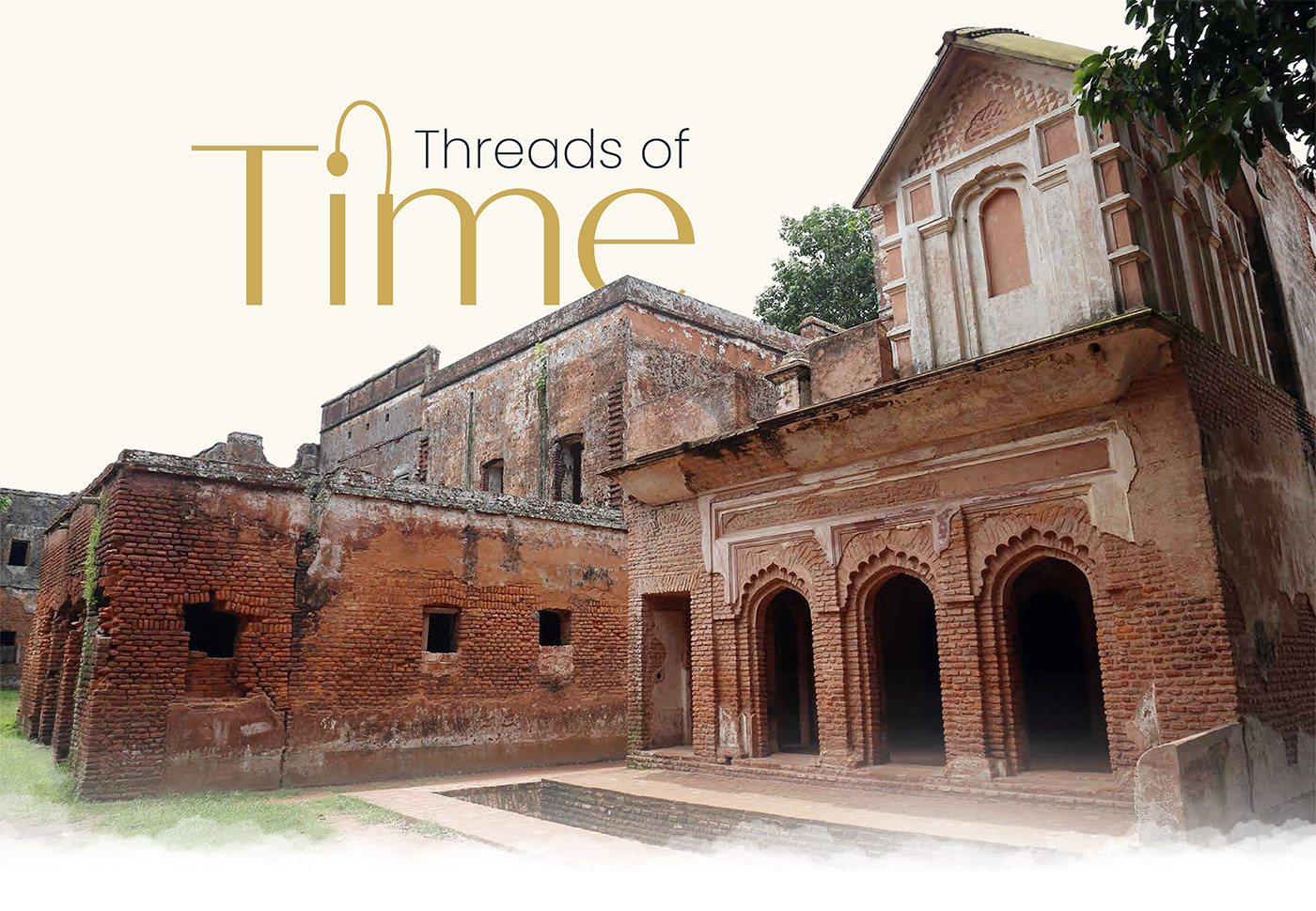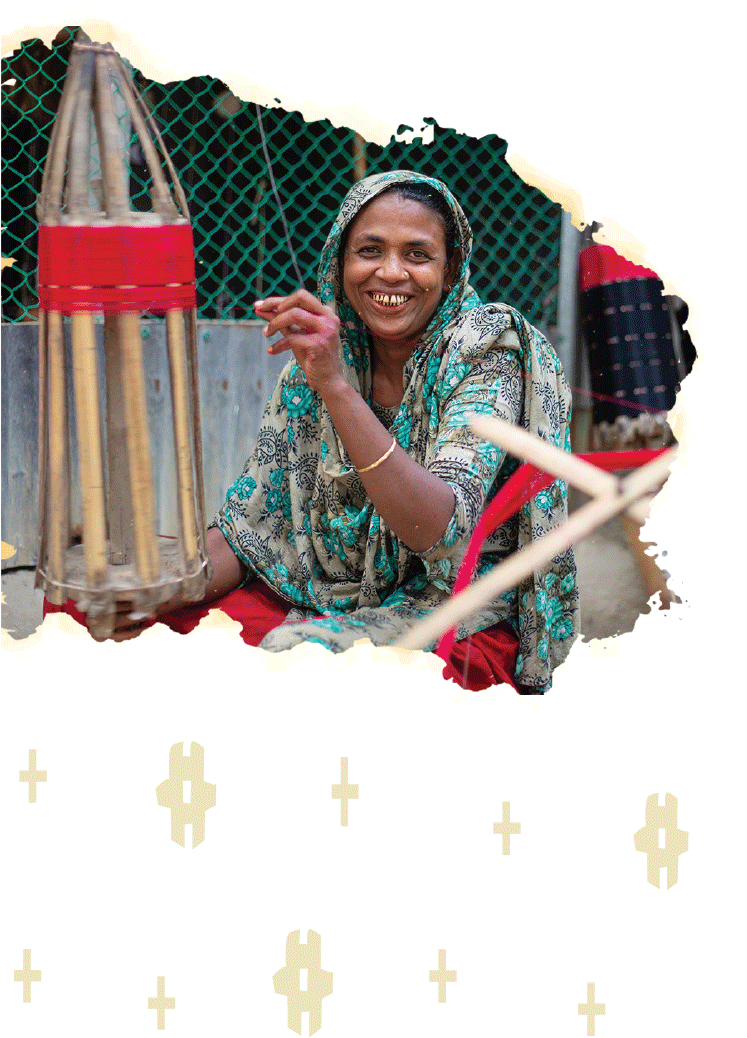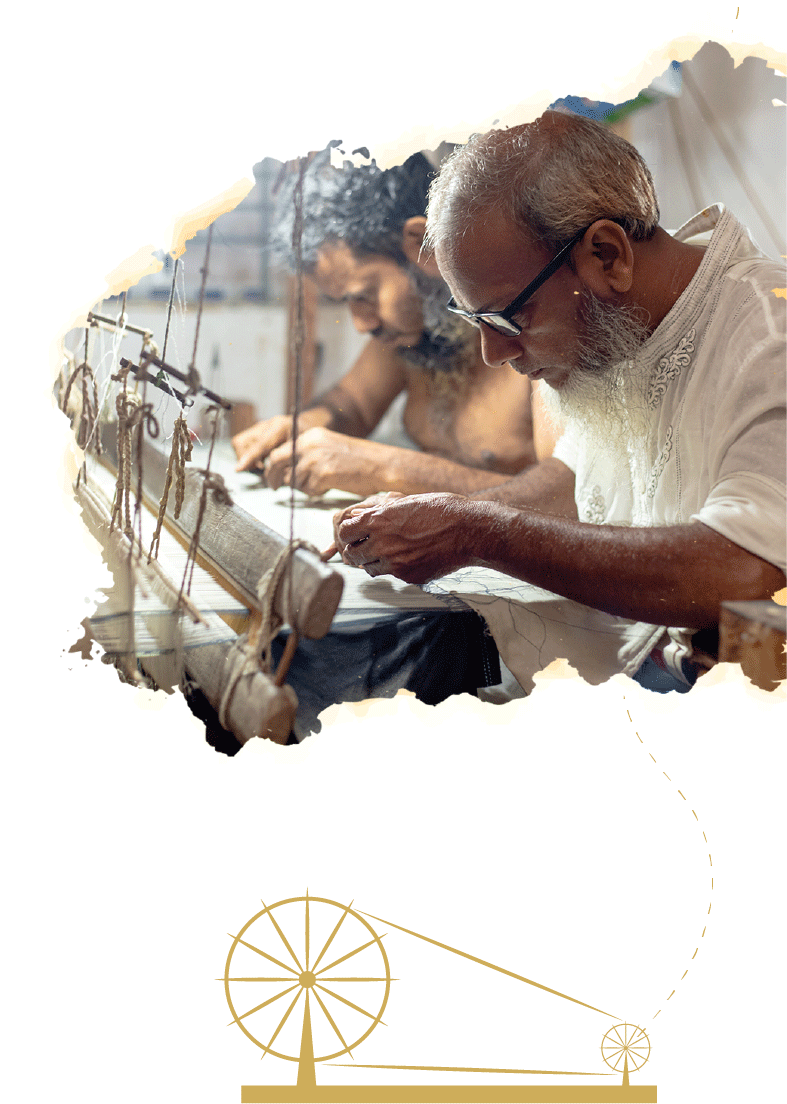
Bangladesh's rich textile tapestry spans over a millennium, encompassing delicate Muslin, timeless Tant and Rajshahi Silk, captivating Manipuri textiles, and more. These traditions showcase a diverse heritage, inspiring endless fashion possibilities.
Centuries ago, Muslin, the pride of Bengal, mesmerised the world with its delicate fineness.
The ethereal beauty of Muslin, with its sheer delicacy and unparalleled softness, remains a timeless testament to Bangladesh's textile heritage.
The mastery of Muslin production allowed Bengal to flourish economically, solidifying its position as a global hub for textile trade and establishing its reputation as a centre of unparalleled textile artistry.
Jamdani, known for its exquisite motifs and intricate hand-weaving techniques, has long adorned the affluent ladies of Bengal and the sub-continent. This fine muslin fabric is meticulously woven with cotton threads, creating delicate patterns of flowers, paisleys, and geometric shapes.
Jamdani's exceptional craftsmanship and cultural significance led to its recognition as a UNESCO Intangible Cultural Heritage. Its unique weaving techniques and regional identity have been safeguarded through the Geographical Indication (GI) status.
Khadi fabric, championed during the anti-colonial independence movement, is hand-spun and hand-woven from natural fibres, symbolizing self-sufficiency and resilience.
Tant sarees, made from hand-woven cotton, are cherished for their lightweight comfort and breathability. They feature intricate borders and traditional motifs, reflecting the rich cultural heritage of Bangladesh.
Rajshahi Silk, crafted from the finest silk fibres, exudes opulence and elegance. It is known for its smooth texture, vibrant colours, and intricate designs, making it a prized possession for special occasions.
Manipuri textiles showcase a fusion of local artistry and cultural heritage. They are crafted using traditional techniques, with motifs inspired by nature, mythology, and traditional designs.
Kantha, a traditional embroidery technique from Bengal, involves the intricate stitching of layers of discarded fabric to create beautiful and functional textiles. The motifs and patterns in Kantha reflect the rich folklore and daily life of the region, adding a touch of artistry and storytelling to the fabric.
The ethereal beauty of Muslin, with its sheer delicacy and unparalleled softness, remains a timeless testament to Bangladesh's textile heritage.
The mastery of Muslin production allowed Bengal to flourish economically, solidifying its position as a global hub for textile trade and establishing its reputation as a centre of unparalleled textile artistry.
Jamdani, known for its exquisite motifs and intricate hand-weaving techniques, has long adorned the affluent ladies of Bengal and the sub-continent. This fine muslin fabric is meticulously woven with cotton threads, creating delicate patterns of flowers, paisleys, and geometric shapes.
Jamdani's exceptional craftsmanship and cultural significance led to its recognition as a UNESCO Intangible Cultural Heritage. Its unique weaving techniques and regional identity have been safeguarded through the Geographical Indication (GI) status.
Khadi fabric, championed during the anti-colonial independence movement, is hand-spun and hand-woven from natural fibres, symbolizing self-sufficiency and resilience.
Tant sarees, made from hand-woven cotton, are cherished for their lightweight comfort and breathability. They feature intricate borders and traditional motifs, reflecting the rich cultural heritage of Bangladesh.
Rajshahi Silk, crafted from the finest silk fibres, exudes opulence and elegance. It is known for its smooth texture, vibrant colours, and intricate designs, making it a prized possession for special occasions.
Manipuri textiles showcase a fusion of local artistry and cultural heritage. They are crafted using traditional techniques, with motifs inspired by nature, mythology, and traditional designs.
Kantha, a traditional embroidery technique from Bengal, involves the intricate stitching of layers of discarded fabric to create beautiful and functional textiles. The motifs and patterns in Kantha reflect the rich folklore and daily life of the region, adding a touch of artistry and storytelling to the fabric.

Centuries ago, Muslin, the pride of Bengal, mesmerised the world with its delicate fineness.
The ethereal beauty of Muslin, with its sheer delicacy and unparalleled softness, remains a timeless testament to Bangladesh's textile heritage.
The mastery of Muslin production allowed Bengal to flourish economically, solidifying its position as a global hub for textile trade and establishing its reputation as a centre of unparalleled textile artistry.
Jamdani, known for its exquisite motifs and intricate hand-weaving techniques, has long adorned the affluent ladies of Bengal and the sub-continent. This fine muslin fabric is meticulously woven with cotton threads, creating delicate patterns of flowers, paisleys, and geometric shapes.
Jamdani's exceptional craftsmanship and cultural significance led to its recognition as a UNESCO Intangible Cultural Heritage. Its unique weaving techniques and regional identity have been safeguarded through the Geographical Indication (GI) status.
Khadi fabric, championed during the anti-colonial independence movement, is hand-spun and hand-woven from natural fibres, symbolizing self-sufficiency and resilience.
Tant sarees, made from hand-woven cotton, are cherished for their lightweight comfort and breathability. They feature intricate borders and traditional motifs, reflecting the rich cultural heritage of Bangladesh.
Rajshahi Silk, crafted from the finest silk fibres, exudes opulence and elegance. It is known for its smooth texture, vibrant colours, and intricate designs, making it a prized possession for special occasions.
Manipuri textiles showcase a fusion of local artistry and cultural heritage. They are crafted using traditional techniques, with motifs inspired by nature, mythology, and traditional designs.
Kantha, a traditional embroidery technique from Bengal, involves the intricate stitching of layers of discarded fabric to create beautiful and functional textiles. The motifs and patterns in Kantha reflect the rich folklore and daily life of the region, adding a touch of artistry and storytelling to the fabric.
The ethereal beauty of Muslin, with its sheer delicacy and unparalleled softness, remains a timeless testament to Bangladesh's textile heritage.
The mastery of Muslin production allowed Bengal to flourish economically, solidifying its position as a global hub for textile trade and establishing its reputation as a centre of unparalleled textile artistry.
Jamdani, known for its exquisite motifs and intricate hand-weaving techniques, has long adorned the affluent ladies of Bengal and the sub-continent. This fine muslin fabric is meticulously woven with cotton threads, creating delicate patterns of flowers, paisleys, and geometric shapes.
Jamdani's exceptional craftsmanship and cultural significance led to its recognition as a UNESCO Intangible Cultural Heritage. Its unique weaving techniques and regional identity have been safeguarded through the Geographical Indication (GI) status.
Khadi fabric, championed during the anti-colonial independence movement, is hand-spun and hand-woven from natural fibres, symbolizing self-sufficiency and resilience.
Tant sarees, made from hand-woven cotton, are cherished for their lightweight comfort and breathability. They feature intricate borders and traditional motifs, reflecting the rich cultural heritage of Bangladesh.
Rajshahi Silk, crafted from the finest silk fibres, exudes opulence and elegance. It is known for its smooth texture, vibrant colours, and intricate designs, making it a prized possession for special occasions.
Manipuri textiles showcase a fusion of local artistry and cultural heritage. They are crafted using traditional techniques, with motifs inspired by nature, mythology, and traditional designs.
Kantha, a traditional embroidery technique from Bengal, involves the intricate stitching of layers of discarded fabric to create beautiful and functional textiles. The motifs and patterns in Kantha reflect the rich folklore and daily life of the region, adding a touch of artistry and storytelling to the fabric.
Bangladesh embraces its rich heritage and promising future in harnessing natural fibers such as jute, bamboo, and banana, while celebrating the endless possibilities of natural dyes like indigo.
These are some of the diverse textile traditions that embody the skilled craftsmanship and cultural richness of Bangladesh, offering a treasure trove of inspiration for fashion enthusiasts worldwide.
The trade routes of ancient times, such as the Silk Road and maritime trade, facilitated the demand for Bangladeshi textiles, drawing merchants and admirers from far and wide, seeking exquisite craftsmanship and luxurious fabrics that were treasured across the globe.
However, the colonial era cast a shadow over Bangladesh's textile trade, stifling its once-thriving industry and restricting its creative potential.
The 1971 Liberation War ignited a transformative spirit within Bangladesh.
Bangladesh's garments industry combines skilled artisans, entrepreneurship, and sustainable practices, empowering individuals and drawing global attention.
With world-class factories, cutting-edge technology, and exceptional craftsmanship, Bangladesh solidifies its position as a global apparel powerhouse.
As Bangladesh's garments industry continues to thrive, the prospect of a heritage-inspired fashion manufacturing sector, especially in the realm of high-end fashion, shines brightly.
In a world where diversity and inclusivity are celebrated, there is a growing global interest in local cultures, traditions, and practices.
Bangladesh's rich textile heritage serves as a wellspring of inspiration, fostering a multicultural and accommodative society that embraces and celebrates its diverse roots.
Unleashing heritage, Bangladesh embraces its rich cultural tapestry, infusing it into contemporary fashion, and creating a captivating fusion of tradition and modernity.
These are some of the diverse textile traditions that embody the skilled craftsmanship and cultural richness of Bangladesh, offering a treasure trove of inspiration for fashion enthusiasts worldwide.
The trade routes of ancient times, such as the Silk Road and maritime trade, facilitated the demand for Bangladeshi textiles, drawing merchants and admirers from far and wide, seeking exquisite craftsmanship and luxurious fabrics that were treasured across the globe.
However, the colonial era cast a shadow over Bangladesh's textile trade, stifling its once-thriving industry and restricting its creative potential.
The 1971 Liberation War ignited a transformative spirit within Bangladesh.
Bangladesh's garments industry combines skilled artisans, entrepreneurship, and sustainable practices, empowering individuals and drawing global attention.
With world-class factories, cutting-edge technology, and exceptional craftsmanship, Bangladesh solidifies its position as a global apparel powerhouse.
As Bangladesh's garments industry continues to thrive, the prospect of a heritage-inspired fashion manufacturing sector, especially in the realm of high-end fashion, shines brightly.
In a world where diversity and inclusivity are celebrated, there is a growing global interest in local cultures, traditions, and practices.
Bangladesh's rich textile heritage serves as a wellspring of inspiration, fostering a multicultural and accommodative society that embraces and celebrates its diverse roots.
Unleashing heritage, Bangladesh embraces its rich cultural tapestry, infusing it into contemporary fashion, and creating a captivating fusion of tradition and modernity.

Bangladesh embraces its rich heritage and promising future in harnessing natural fibers such as jute, bamboo, and banana, while celebrating the endless possibilities of natural dyes like indigo.
These are some of the diverse textile traditions that embody the skilled craftsmanship and cultural richness of Bangladesh, offering a treasure trove of inspiration for fashion enthusiasts worldwide.
The trade routes of ancient times, such as the Silk Road and maritime trade, facilitated the demand for Bangladeshi textiles, drawing merchants and admirers from far and wide, seeking exquisite craftsmanship and luxurious fabrics that were treasured across the globe.
However, the colonial era cast a shadow over Bangladesh's textile trade, stifling its once-thriving industry and restricting its creative potential.
The 1971 Liberation War ignited a transformative spirit within Bangladesh.
Bangladesh's garments industry combines skilled artisans, entrepreneurship, and sustainable practices, empowering individuals and drawing global attention.
With world-class factories, cutting-edge technology, and exceptional craftsmanship, Bangladesh solidifies its position as a global apparel powerhouse.
As Bangladesh's garments industry continues to thrive, the prospect of a heritage-inspired fashion manufacturing sector, especially in the realm of high-end fashion, shines brightly.
In a world where diversity and inclusivity are celebrated, there is a growing global interest in local cultures, traditions, and practices.
Bangladesh's rich textile heritage serves as a wellspring of inspiration, fostering a multicultural and accommodative society that embraces and celebrates its diverse roots.
Unleashing heritage, Bangladesh embraces its rich cultural tapestry, infusing it into contemporary fashion, and creating a captivating fusion of tradition and modernity.
These are some of the diverse textile traditions that embody the skilled craftsmanship and cultural richness of Bangladesh, offering a treasure trove of inspiration for fashion enthusiasts worldwide.
The trade routes of ancient times, such as the Silk Road and maritime trade, facilitated the demand for Bangladeshi textiles, drawing merchants and admirers from far and wide, seeking exquisite craftsmanship and luxurious fabrics that were treasured across the globe.
However, the colonial era cast a shadow over Bangladesh's textile trade, stifling its once-thriving industry and restricting its creative potential.
The 1971 Liberation War ignited a transformative spirit within Bangladesh.
Bangladesh's garments industry combines skilled artisans, entrepreneurship, and sustainable practices, empowering individuals and drawing global attention.
With world-class factories, cutting-edge technology, and exceptional craftsmanship, Bangladesh solidifies its position as a global apparel powerhouse.
As Bangladesh's garments industry continues to thrive, the prospect of a heritage-inspired fashion manufacturing sector, especially in the realm of high-end fashion, shines brightly.
In a world where diversity and inclusivity are celebrated, there is a growing global interest in local cultures, traditions, and practices.
Bangladesh's rich textile heritage serves as a wellspring of inspiration, fostering a multicultural and accommodative society that embraces and celebrates its diverse roots.
Unleashing heritage, Bangladesh embraces its rich cultural tapestry, infusing it into contemporary fashion, and creating a captivating fusion of tradition and modernity.